If external companies are entrusted with the storage, handling or transport of goods, they must fulfill their duties as carefully as if they were dealing with their own goods. They must ensure that nothing is spoilt or damaged and that articles and materials entrusted to them cannot have a damaging effect on other goods or on the environment.
This obligation to exercise due care entails an important principle concerning the provision of suitable storage areas and handling and transport equipment:
- Open or closed areas intended to receive goods must have facilities and characteristics suitable for transporting or storing these goods. They must be in a state or be brought into a state which allows correct and safe transportation.
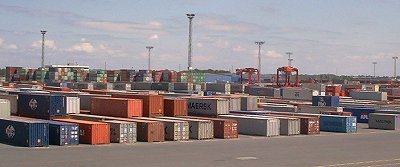 |
|
| Port operation with all the facilities required for correct transportation |
This results in a series of obligations and activities for all staff involved in the supervision, storage, handling and transport of goods to ensure smooth shipment of those goods. These include, most importantly, the accurate planning and sophisticated organization of all processes. Otherwise, errors can propagate to every area of goods handling.
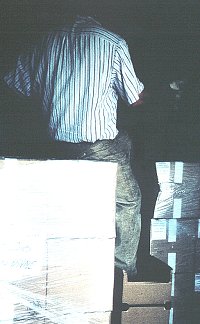 |
"Trampling" on packages must be strictly forbidden. |
Good organization involves not only clear procedural instructions but will also ensure that these instructions are observed and monitored and that the staff receive regular training.
This section provides a brief summary of important preparatory work. More detailed information on some of the specific issues outlined there will be found in separate sections. The actual work procedures and final work is dealt with in separate sections.
Preparatory work for the orderly acceptance or handing over of a load includes particularly the following tasks:
The selection of suitable facilities for storage, handling and transport of goods and adequate stowage and storage space is the particular task of all persons involved with the logistics for vehicles, containers or devices, and of shed or warehouse managers. They must ensure that suitable means of transport, ground conveyors and other equipment are available in the right place at the scheduled time. Outdoor short and long-term storage areas, covered hangars, sheds and warehouses should be marked out beforehand and dedicated to receiving specific goods. Staff under instructions have little influence in these considerations. Exceptions to this arise if staff are permitted to freely select from a series of empty containers. The loading staff in ports have no influence on the stowage locations for CTUs on board ships. These locations are specified by the stowage centers of the shipping companies or by the shipmasters.
Checking or establishing fitness for loading is an important prerequisite for being able to begin packing. Irrespective of the type of cargo transport unit used, fitness for loading must be established. The same also applies for short and long-term storage areas. They also must be in an adequate state to allow the goods to be stored safely and without damage. If this is not already the case, they must be brought into this state. Different properties of the different goods which constitute a load necessitate different requirements. Only a few general principles will be dealt with here. Although some concessions can be made under certain circumstances, they will also have to be supplemented by further measures under other circumstances. The term "fitness for loading" implies that work can be begun without delay. It may be necessary to line or pad out the floor of the area with boards, planks, squared lumber etc. It must be possible to handle the goods by lifting gear or ground conveyors without difficulty.
 |
This step on the threshold presents a risk for staff, equipment and load |
Fitness for loading also means that permitted stacking loads, wheel loads or axle loads are (can be) observed. Otherwise, the result could be damage to vehicles, stowage or storage areas or the goods that make up the load. Sometimes, the permissible load stated is clearly visible. Sometimes, it can easily be ascertained. In some cases, it must be taken from the relevant regulations.
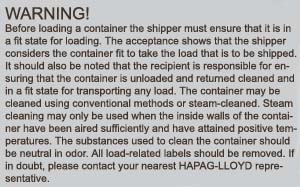 |
Notice in a container |
| The degree to which a container must be clean must always be considered in relation to the particular goods to be stored or transported. The requirements for stowage space and holds will naturally differ for coffee, spices and other foods and foodstuffs compared with, for instance, granite blocks, steel, machine parts or hazardous materials. | 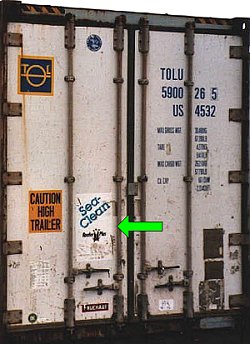 |
| Notice indicating that the container has been cleaned |
|
The minimum requirement is that the stowage space is swept out:
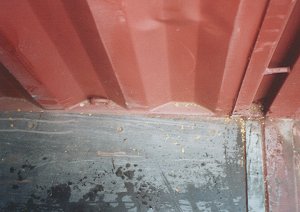 |
Not swept out, and even traces of moisture |
In this context, it is important not only that the floor is swept out, but also that any other dusty or contaminated parts, such as side and end walls, doors, roofs, covers, stanchions etc. are cleaned appropriately. Basic cleaning can prevent not just soiling or contamination but also chemical reactions. Sweeping out is also valuable on a physical level, since it generally improves the friction factor of the floor - dusty floors exhibit a lower coefficient of sliding friction.
| Very smooth container floor |
 |
Absence or neutrality of odor is always required when odor-absorbing goods are stored or transported, otherwise their value could be adversely affected. Ensuring absence or neutrality of odor also means not using any odor-tainted or odor-emitting load securing equipment, dunnage or segregating materials in places where they could cause damage. Loads which can (could) negatively impact on each other must not be loaded together. Odor-neutrality is not required for the means of transport and accompanying load with most dangerous cargoes, but it can be important for certain chemicals. If odor-neutrality is required, appropriate information must be provided to the relevant offices. This is especially important if a molecular influence from other goods would have a damaging effect. In many cases, it is sufficient to remove residue from previous loads and to air thoroughly. Sometimes, it is useful to spray odor-binding chemicals, which should be environmentally friendly and in no way health-threatening or even toxic.
Special measures are required for storing, handling and transporting loads which are particularly odor-sensitive. The same applies if strong or badly smelling or dangerous loads have been shipped and the affected areas have to be prepared specially or restored before a load can be accepted. Extensive cleaning work, such as washing etc. can then be necessary. There are specialist companies on the transport market who offer these services.
Decontamination with special chemicals must be ordered specially and must be monitored. In certain cases, specialist companies with specially trained staff are to be called in.
Storage space and cargo transport units must be dry and offer protection from moisture, unless otherwise contractually agreed or this is not customary practice in a given trade. Generally, however, they must not show any defects which could lead to damage by moisture. Wet patches are to be removed by applying sawdust, dry sand or other absorbent materials and sweeping them up. Certain circumstances make it necessary to use special binders. In the simplest case, a thorough airing with "relatively" dry air is sufficient. To prevent moisture damage from occurring at a later date, the storage and stowage areas and means of transport must be inspected for leaks etc. This also means checking pipework, roofs, tarpaulins, doors, ventilation openings etc. and in particular checking the seals.
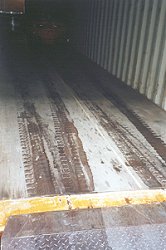 |
Moisture brought into a container by staff and forklifts |
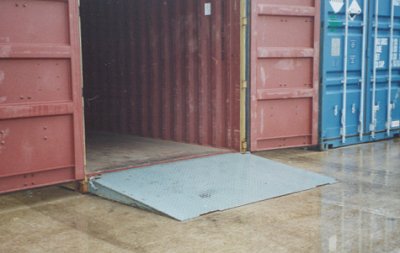 |
|
| Danger of moisture being brought into a container |
On rainy days such as this, no containers should be packed outside. It is another mark of good organization that either covered areas are provided or work is stopped under these conditions.
Long and short-term storage areas and cargo transport units must be free of any articles which could cause mechanical damage. They must therefore be inspected for materials which could damage the load, such as old load securing material, protruding mountings, incorrectly inserted roof bows or slats, sharp or pointed objects, etc. If there is a risk of damage, these items must be removed. This also includes removing old wires, wood splinters, nails, small stones etc. All protruding mountings, lashing rings, and sharp and pointed objects which cannot be removed, are to be covered. Carelessness during this work can not only cause significant damage to the goods themselves, but also consequential losses when the goods are further processed. An example of this is an instance of damage which occurred during the transport of newsprint in a container in which bags with plastic pellets had previously been transported. Due to inadequate cleaning, individual pellets became embedded in the paper rolls. When the rolls were subsequently processed, the granules brought a complete printing line to a standstill. The damage caused was enormous.
Inspections and protective measures are necessary before using cargo handling equipment, load-bearing equipment, mechanical aids, tools etc. They must not cause tears, pinching, pressure points, scratches, soiling or a reduction of quality or safety standards which depreciate the value of the goods. Defective equipment must be repaired so that it is suitable for use or be rejected. This includes checking the loading capacity of ground conveyors and lifting gear, load-bearing equipment, etc. The materials used must be adequate to meet the requirements for correct segregation and correct use of dunnage. They must be available in a sufficient quantity and be of an adequate quality. Any missing stock must be made up in good time, to prevent any delays. Unusable materials must be rejected. Load securing means and transport protection equipment which have been installed or supplied are to be inspected to ensure they are ready to use, complete and in perfect condition. This includes stanchions, trailer rails, roof bow mountings or slats, partitions, permanently installed lashing systems, airbags, etc.
The provision and selection of conventional load securing equipment must be organized in good time. The most suitable materials are to be selected from those which are available or provided. Unusable parts must be rejected. Claims for incorrect or incomplete deliveries must be made in good time, to prevent time delays during purchasing or replacement delivery. Materials of this type could be: Steel wire, wire rope clamps, shackles, turnbuckles, steel strapping, lashing belts, lashing ropes, wood, etc. If individual items load securing equipment are passed on to third parties or used by third parties, this must be documented by appropriate receipts, etc.
Preparation of stowage, packing and storage areas or spaces must also include leveling any uneven surfaces. All surfaces, including container floors, must be prepared so as to enable work to be carried out without any delay. If goods are to be packed in several layers, it may be necessary to line, flatten or pad out the floor of the area with boards, planks, squared lumber etc. It must be possible to handle the goods by lifting gear or ground conveyors without difficulty.
The load-carrying capacity and the permissible loading capacity of the underlying surface must be checked. Permissible and required stacking loads, axle loads and wheel loads must be compared. Exceeding the permissible loading capacity or loads can result in damage to the operating equipment or cargo transport units. For some storage areas and CTUs, the permissible load or load-bearing capacity is clearly visible. It can sometimes be determined simply by dividing the load-bearing capacity or load limit by the loading area. The "General guidelines" of the UVV (a national German regulation) stipulate that permissible values must not be exceeded.
Necessary protective clothing and equipment must be requested and provided in good time. Basic safety clothing includes: Safety helmets, steel-capped safety boots with impervious soles and gloves. Gloves are indispensable for protection against "frayed edges" in wire ropes, splinters on rough wood, etc. When dealing with dangerous cargoes or working materials, it can be mandatory to use special protective clothing and equipment. Dust masks, filter masks or gas masks, acid-resistant footwear, antistatic footwear, rubber aprons, rubber boots, rubber gloves etc. must then be worn. It must be noted that even very traces of alcohol in the breath of the user can render certain filters ineffective. When using chainsaws, "saw-proof" clothing, ear protectors and face protection must be worn. Employers must provide the relevant safety equipment, employees must use it.
All necessary resources must be kept ready for planning and documenting packing operations. Computer lists, forms, marking pens and pencils, placards, rules, measuring tapes, etc. must be immediately accessible or available at all times, to prevent delays during handling.
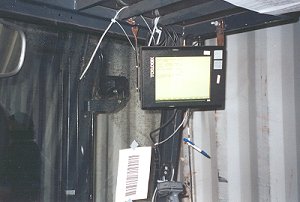 |
An advantage: Electronic support for packing with a forklift |
Electronic support facilitates documentation and accelerates the handling process.
Supervisory authorities and specialists must be requested and informed in good time. These may be radiation protection experts, persons with appropriate qualifications for handling explosives or similar experts, who must be present during handling. Frequently, fire services, veterinary or plant protection officers, customs or similar authorities must also be brought in. In some cases, firefighting equipment must be to hand and the appropriate staff must be readily accessible. Provisions may need to be made for monitoring the handling process or the containers.
In some cases, it is required that extensive information is provided to the staff. When handling dangerous goods, all staff and other persons involved must be instructed before work begins about the special properties and risks associated with the load, and what protective measures need to be taken.
The names of all supervisors must be known to all persons involved in the monitoring process. A written record must be kept of the names of the appointed supervisors.
According to the CTU guidelines:
-
"responsible person" means a person appointed by a shore-side employer who is empowered to take all decisions relating to his/her specific task, having the necessary current knowledge and experience for that purpose, and who, where required, is suitably certificated or otherwise recognized by the regulatory authority.
| Hopefully he has not overlooked the fact that on one of the cartons, a label is only printed in black, and not permanently attached as a "colored label". | 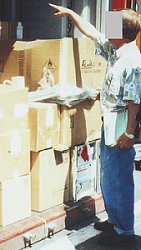 |
| Responsible person? |
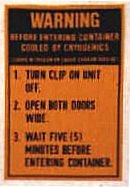 |
It is essential that all safety instructions on the containers are observed. These instructions, for instance, stipulate that the refrigeration unit must be switched off, the doors must be opened wide and five minutes must elapse before entering the container: | |
| Warning notice on a refrigerated container |
| To make provision for emergencies, staff should be informed about the location of fire alarms, emergency exits, the nearest stretcher and all relevant emergency numbers. In addition, every employee must be acquainted with the reporting procedures and general procedures in the event of faults and accidents occurring. | 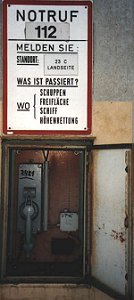 |
Trade association demands for safe workplaces must be met. These include adequately lit traffic routes and freely accessible escape routes. In Germany, for instance, one of the requirements is that:
-
The employer must ensure that only ramps which cover the entire width of the container are used when driving onto containers with ground conveyors.
 |
|
| Ramp |
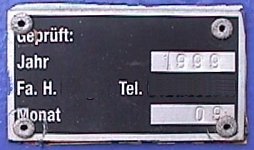 |
Inspection plate for the ramp |
It is obvious that safety-relevant aids of this kind must be checked regularly.
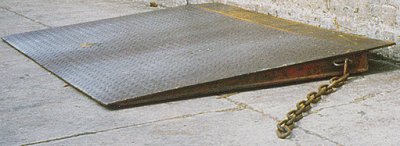 |
|
| Ramp |
| (2) | Drivers of ground conveyors must only drive onto containers and vehicles once all necessary ramps and bridging have been set up and secured against unintentional movement. |
 |
Ramp secured against unintentional movement |
When driving onto containers, ramps are considered to be secured if they have been hooked into the containers or, for instance, lashed to the container with chains.
| Not forbidden: Provisionally securing a ramp with chains |  |
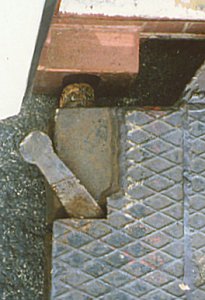 |
Even better: Securing a ramp with bolts |
| Unsecured ramp | 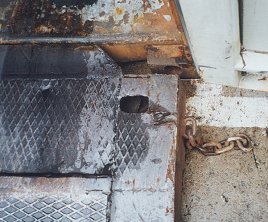 |
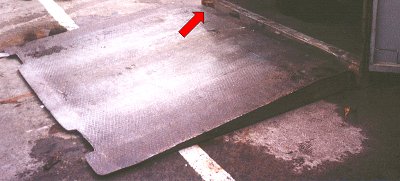 |
|
| Accident hazard caused by unsecured ramp |
 |
Workers must use equipment to protect against falling when working more than 2 m above the ground or above the height of a single container. | |
| Employee protected against falling |